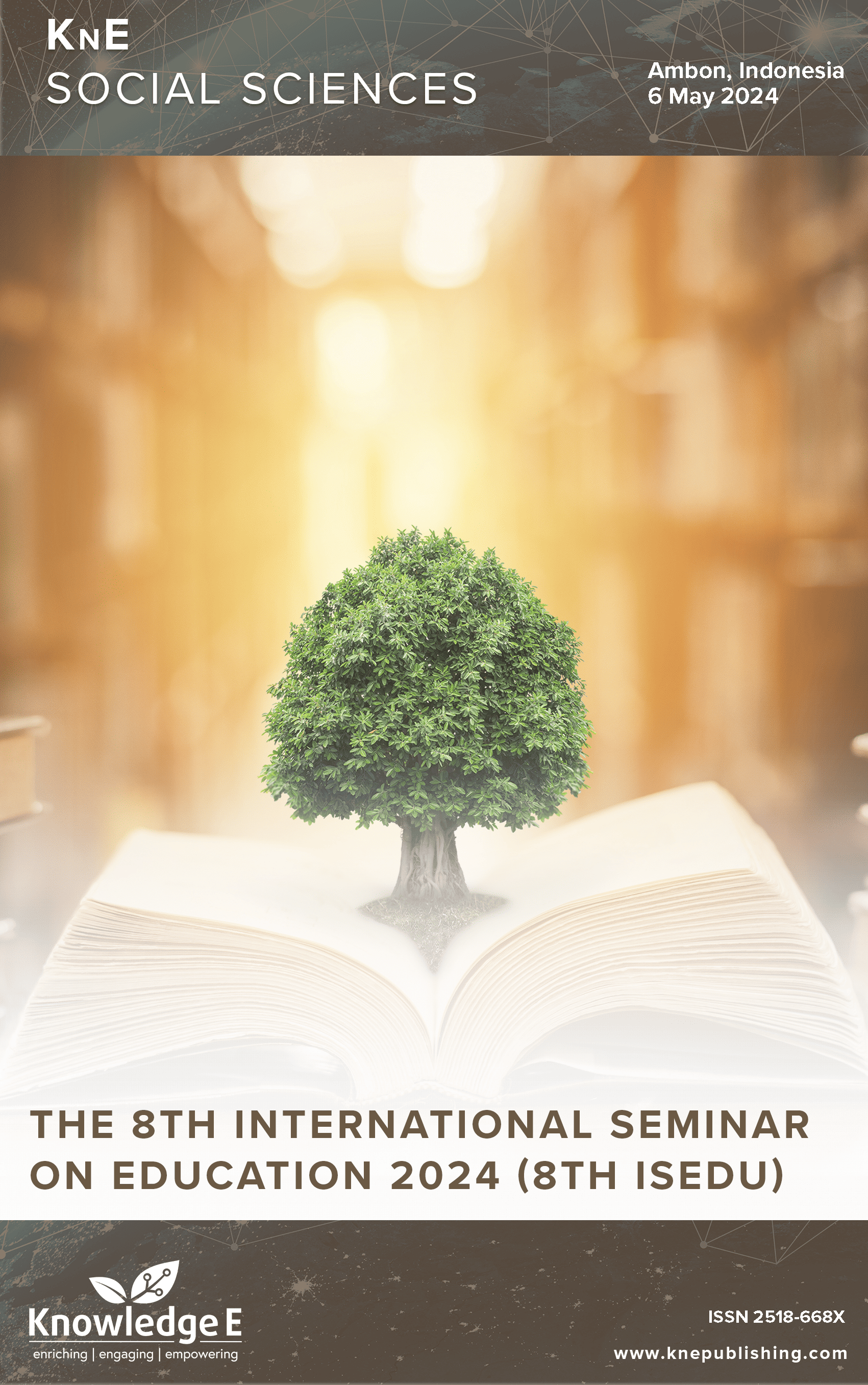Local Potential Management for Poverty Alleviation in Maluku
DOI:
https://doi.org/10.18502/kss.v9i31.17581Abstract
Poverty, as a social problem, has a significant impact on human life. Therefore, various theories have been produced for poverty alleviation, followed by various policies. It is carried out by the governments of sovereign countries, organizations, families, and personal efforts. Nevertheless, poverty still exists and even shows fluctuating numbers, as if poverty cannot be eradicated from the lives of humanity. The Central Bureau of Statistics shows that Indonesia’s population in March 2023 reached 280.73 million people with a poverty rate of 9.36% or 29.9 million people, above the average poor population of the world community. In Maluku, the poverty rate was 16.42% in September 2023, which represents 301.61 thousand people. It is an increase from the previous year, which places the poverty of the Maluku people above the average of the world’s poor and the average of the poor in Indonesia. Through research with a unique sociological approach to system theory by Talcott Parsons with his AGIL, it was found that in rural communities, especially in sago-producing countries, poverty can be alleviated not in a moment but sustainably with the quality of life of the community and the quality of the environment that constantly increases. Through qualitative research conducted, it was found that managing and cultivating sago regularly will have an impact on increasing community income, the emergence of new water sources resulting in the emergence of many aquatic animals, the opening of various business lands, the natural environment becomes cool and fertile, and various other benefits. In this way, poverty can be erased in sago-producing communities, with the quality of community life and the environment continuing to improve.
Keywords: local potential, poverty alleviation, Maluku
References
Sugiharti L, Purwono R, Esquivias MA, Jayanti AD. Poverty dynamics in Indonesia: The prevalence and causes of chronic poverty. J Popul Soc Stud. 2022;30:423–47. DOI: https://doi.org/10.25133/JPSSv302022.025
Afandi A, Dwi Wahyuni JS. “Policies to eliminate poverty rate in Indonesia”. Int J Econ Financ Issues. 2017;7(1):435–41.
Wiranatakusuma DB, Primambudi G. Determinants of poverty in Indonesia | Determinantes de la pobreza en Indonesia. Sociol y Tecnociencia. 2021;11(2):243–67.
Pramono G, Marsisno W. Availability of infrastructure for poverty reduction in Indonesia: Spatial panel data analysis. Econ Financ Indones. 2018;64(2):157–80.
Purwono R, Wardana WW, Haryanto T, Khoerul Mubin M. Poverty dynamics in Indonesia: Empirical evidence from three main approaches. World Dev Perspect. 2021;23:1–9. DOI: https://doi.org/10.1016/j.wdp.2021.100346
Mood C, Jonsson JO. The social consequences of poverty: An empirical test on longitudinal data. Soc Indic Res. 2016;127(2):633–52. DOI: https://doi.org/10.1007/s11205-015-0983-9
Darling-Hammond L. “New standards and old inequalities: School reform and the education of African American Students.” Black Educ. A Transform. Res. Action Agenda New Century. 2000;69(4):263–87. DOI: https://doi.org/10.2307/2696245
Varyzgina A, Kay R. Perceptions of poverty in small-town Russia. Debatte Rev Contemp Ger Aff. 2014;22(3):269–87. DOI: https://doi.org/10.1080/0965156X.2014.988498
Siaila S, Rumerung D. Analysis of the profitability of small pelagic capture fisheries in Ambon City, Indonesia. Aquacult Aquarium Conserv Legis. 2022;15(2):608–62.
Pattinaja EM, Abrahamsz J, Loppies LR. Blue economy accounting model for tuna fisher groups in Maluku Province, Indonesia. Aquacult Aquarium Conserv Legis. 2023;16(4):2060–71.
Titaley E. Utilizing sago to reduce poverty. OAlib. 2015;02(01):1–6. DOI: https://doi.org/10.4236/oalib.1101236
Titaley E, Kanto S, Wisadirana D, Mardiyono M. Poverty and local potentials. Ecol Environ Conserv. 2018;24(3):1092–103.
Teniwut WA. For sustainable revenue of fisheries sector in small islands: evidence of Maluku, Indonesia. Aquacult Aquarium Conserv Legis. 2016;9(3):722–32.
Marten G, Matsuda Y, Bardach J, Comitini S, et al. “A Strategic goal analysis of options for tuna longline joint ventures in SoutheastAsia: Indonesia-Japan case study.” 1981;3:1–74. [Online]. Available: https://scholarspace.manoa.hawaii.edu/bitstream/10125/21743/EAPIResRep003StrategicGoalAnalysisOfOptionsForTuna1981%
Ormerod R. The history and ideas of sociological functionalism: Talcott Parsons, modern sociological theory, and the relevance for OR. J Oper Res Soc. 2020;71(12):1873–99. DOI: https://doi.org/10.1080/01605682.2019.1640590
Al Manar P, Zuhud EA, Andarwulan N, Bintoro MH. Morphological characteristics and potential of sago (Metroxylon spp.) in Lingga Regency, Riau Islands, Indonesia. J Manaj Hutan Trop. 2023;29(1):11–21. DOI: https://doi.org/10.7226/jtfm.29.1.11
Hayanti N, Purwanto R, Kadir AW. “Preferensi masyarakat terhadap makanan berbahan baku sagu (Metroxylon Sagu Rottb) sebagai alternatif sumber karbohidrat Di Kabupaten Luwu dan Luwu Utara Sulawesi Selatan.” J Penelit Sos dan Ekon Kehutan. 2014;11(1):82–90. DOI: https://doi.org/10.20886/jsek.2014.11.1.82-90
Ahmad M. Farmer empowerment to increase productivity of sago (Metroxylon sago spp) Farming. Int J Adv Sci Eng Inf Technol. 2014;4(3):129. DOI: https://doi.org/10.18517/ijaseit.4.3.384
Trisia MA, Metaragakusuma AP, Osozawa K, Bai H. Promoting sago palm in the context of national level: Challenges and strategies to adapt to climate change in Indonesia. Int J Sustain Futur Hum Secur. 2016;4(2):54–63. DOI: https://doi.org/10.24910/jsustain/4.2/5463
Bradshaw TK. Theories of poverty and anti-poverty programs in community development. Community Dev (Columb). 2007;38(1):7–25. DOI: https://doi.org/10.1080/15575330709490182
Ukpere WI, Slabbert AD. A relationship between current globalisation, unemployment, inequality and poverty. Int J Soc Econ. 2009;36(1–2):37–46. DOI: https://doi.org/10.1108/03068290910921172
Fernández-Ramos J, Garcia-Guerra AK, Garza-Rodriguez J, Morales-Ramirez G. The dynamics of poverty transitions in Mexico. Int J Soc Econ. 2016;43(11):1082–95. DOI: https://doi.org/10.1108/IJSE-04-2015-0084
Girsang W. Profiles and causes of urban poverty in small islands: A case in Ambon City, Maluku Islands Indonesia. Int. J. Econ. Behav. Organ. 2016;4(3):18. DOI: https://doi.org/10.11648/j.ijebo.20160403.11
Tahir T, Hasan M. Poverty’s characteristics and its reduction strategies: A case study. Eur Res Stud. 2018;21(2):426–40. DOI: https://doi.org/10.35808/ersj/1012
Titaley E, Pariela TD. Isolation: The root cause of indigenous poverty in Lumoli Village. Hunan Daxue Xuebao Shehui Kexue Ban. 2021;48(6):172–82.
Tjokrokusumo D. Potency of sago (metroxylon spp) crops for food diversity. Biodivers Int J. 2018;2(3):239–40. DOI: https://doi.org/10.15406/bij.2018.02.00066
Sasaoka M, Laumonier Y, Sugimura K. Influence of indigenous sago-based agriculture on local forest landscapes in Maluku, east Indonesia. J Trop For Sci. 2014;26(1):75–83.
Metaragakusuma AP, Katsuya O, Bai H. An overview of the traditional use of sago for sago-based food industry in Indonesia. KnE Life Sci. 2016;3(3):119. DOI: https://doi.org/10.18502/kls.v3i3.382
Resdati R, Yusuf Y, Siti R, Sidiq S, Bahagiana B. Derivation of sago processed food in yupaet MSMEs. J Appl Bus Technol. 2024;5(18):8–15. DOI: https://doi.org/10.35145/jabt.v5i1.159
Wulan S. Sago as an environmentally sustainable food. J Environ Sci Sustain Dev. 2018;1(1):63–73. DOI: https://doi.org/10.7454/jessd.v1i1.22
Titaley E. Sustainable ecotourism development In Negeri Lumoli, Maluku-Indonesia : Sociology Studies. Khazanah Sos. 2023;5(1):53–64. DOI: https://doi.org/10.15575/ks.v5i1.23991

